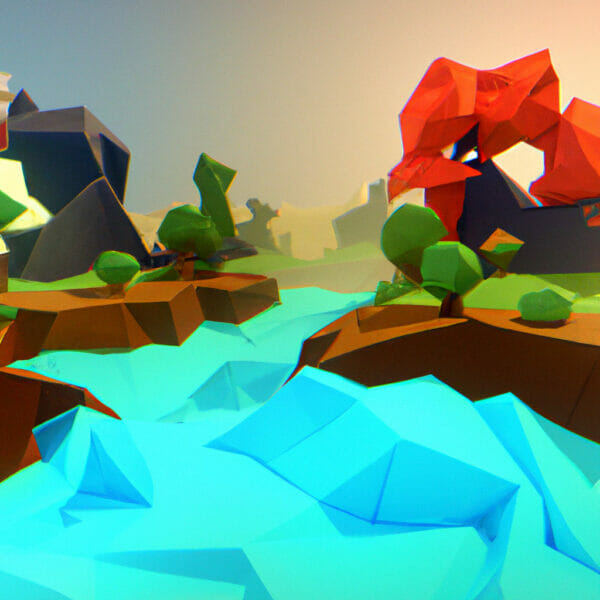Augmented Reality (AR) has taken the world by storm, revolutionizing industries such as gaming, shopping, education, and more. The market for AR is expected to reach a staggering $13 billion by 2023. With the continuous growth of AR technology, learning how to create AR applications is an essential skill for budding developers and tech enthusiasts alike.
To help you get started, we have compiled a complete list of resources (including our top-rated Augmented Reality Mini-Degree) to guide you through the process of making an AR app.
Table of contents
How Does Augmented Reality Work
Augmented Reality (AR) is a technology that superimposes digital information onto the user’s view of the real world, enhancing their perception of their environment. This is achieved using a combination of software and hardware components, such as cameras, sensors, and displays, which work together to overlay digital content onto physical objects in real-time. AR applications can range from simple enhancements, like displaying contextual information about an object, to complex interactive experiences, like gaming or training simulations.
How AR Is Changing App Development
AR is revolutionizing the way we interact with digital content and has opened up new possibilities for app development. By combining the physical and digital worlds, AR offers a more immersive and engaging experience for users. Some key ways AR is changing app development include:
- Adding a new layer of interactivity to apps, making them more engaging and useful to users.
- Enabling developers to create richer, context-aware experiences.
- Blurring the lines between the real and digital worlds, making devices and apps more intuitive and natural to use.
- Expanding the potential for app-based experiences in industries such as gaming, retail, healthcare, and education.
Why Learn AR Development for Apps
As AR continues to gain traction in various industries, learning AR development for apps opens up a world of opportunities for developers to create innovative applications. Advantages of learning AR development include:
- Gaining a competitive edge in the job market, as demand for skilled AR developers increases.
- The ability to create applications with a higher level of interactivity and usefulness.
- The opportunity to be part of a cutting-edge field with significant potential for growth.
- Incorporating AR into existing apps, increasing their value and functionality.
Best Tools for Making AR Apps
There are several tools and platforms available for developing AR apps, including:
- ARKit: An AR development platform from Apple, designed for iOS devices.
- ARCore: Google’s AR development platform, compatible with Android devices.
- Unity: A popular game engine that includes built-in support for AR through its AR Foundation toolkit, enabling cross-platform development for both ARKit and ARCore.
- Vuforia: A widely-used AR development platform that supports a range of devices and includes features such as object recognition and tracking.
- Unreal Engine: Another game engine that offers native support for AR development.
What Skills are Needed to Make AR Apps
To successfully make AR apps, developers need a combination of technical skills and knowledge in areas such as:
- Programming languages, such as C# or Swift.
- 3D modeling and animation.
- Understanding of AR frameworks and SDKs, such as ARKit or ARCore.
- Experience with development tools and platforms, such as Unity or Unreal Engine.
- Knowledge of design principles and user experience (UX) considerations for AR apps.
In the sections below, you’ll find a comprehensive list of resources, including tutorials and tools from Zenva and other sources, to help you get started on your AR app development journey.
Zenva Academy AR Mini-Degree
Whether you’re a beginner or experienced developer, Zenva Academy’s Augmented Reality Mini-Degree is the ultimate resource to learn AR app development. This comprehensive curriculum consists of 11 courses covering Unity, AR Foundation, ARKit, and EasyAR.
The program is designed to be flexible and accessible, offering project-based learning to assist you throughout your learning journey.
CreativeBloq – Build an AR App
Learn how to create a multi-marker augmented reality application using AR.js with this step-by-step guide from CreativeBloq. The article dives into the world of experimental design and demonstrates how to display unique content based on various markers.
Adobe Aero
Adobe Aero is an AR software solution that empowers users to create, view, and share immersive storytelling experiences on mobile and desktop devices. Used across various creative fields, including museums, Adobe Aero is part of Adobe’s extensive suite of creative tools.
UniteAR
Create AR experiences without coding using UniteAR. Users can upload target images and customize digital content like videos, 3D models, and audio. Projects can be tested using UniteAR’s Android or iOS apps or via a mobile web browser.
GameDev Academy – How to Code an AR Application
Gamedev Academy provides an overview of AR technology and its implementation in various industries. The article discusses how developers use ARKit and ARCore SDKs to create AR experiences on iOS and Android devices. Unity’s AR Foundation, which combines ARKit and ARCore SDKs, is also introduced for multi-platform development.
Overlyapp
Overlyapp lets users create DIY augmented reality experiences with its easy-to-use tool. Upload static trigger images and add content like videos, animations, or 3D models to bring your visuals to life. The platform offers a free five-day trial to get started.
Echo3D
Develop and deploy AR apps and 3D content with Echo3D. This cloud platform is compatible with any AR client-side SDK and offers step-by-step guides for building AR apps using echo3D or Unity.
Create AR Using These 5 Apps – ISTE
Explore five apps that can be used to create AR experiences in the classroom in this ISTE article. Each app is evaluated based on cost, platform, ease of use, and features, with step-by-step instructions included.
Conclusion
Whether you’re a beginner or an experienced developer, AR app development is an increasingly valuable skill to possess. With the help of these resources, you can learn the ins and outs of AR development, create engaging AR experiences, and contribute to the growth of this cutting-edge technology.
Don’t forget to check out Zenva Academy’s Augmented Reality Mini-Degree for a comprehensive learning experience!
Did you come across any errors in this tutorial? Please let us know by completing this form and we’ll look into it!

FINAL DAYS: Unlock coding courses in Unity, Godot, Unreal, Python and more.







